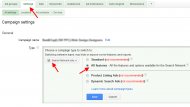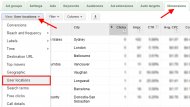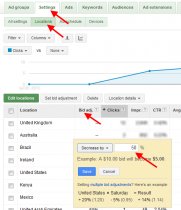 Google AdWords campaigns are usually not considered cost effective for small and medium sized businesses. In reality, these campaigns can be both useful and budget friendly for smaller budget users when they are carefully managed. By using these tips I have learned after spending more than $40, 000 on Google’s advertising product, you can run a successful low budget AdWords campaign.
Google AdWords campaigns are usually not considered cost effective for small and medium sized businesses. In reality, these campaigns can be both useful and budget friendly for smaller budget users when they are carefully managed. By using these tips I have learned after spending more than $40, 000 on Google’s advertising product, you can run a successful low budget AdWords campaign.
1) Campaign Objectives: Before you launch an ad campaign, clarify the reason for the campaign: is it to generate traffic, target specific keywords, or as a marketing stunt against your competitors? Being clear about your objective allows you to create a more effective, targeted ad.
2) Stick to Google Search Networks:
3) Extensive Keywords Research: Bid for generic keywords can be very high. So look for unique and longer keywords to compete effectively on a smaller budget. Find effective long tail keywords using your Analytics account to see organic searches leading to your website, Google auto-complete option, and tools like Google’s Keyword Tool or
 To keep your PPC expenditure in control, keep exact match or phrase match keywords. Speaking of web services industry, choosing exact match keywords such as [web design company] will not display your ad for terms like “website design company” or “web design agency”
To keep your PPC expenditure in control, keep exact match or phrase match keywords. Speaking of web services industry, choosing exact match keywords such as [web design company] will not display your ad for terms like “website design company” or “web design agency”
Targeting keywords like “web design company India” will give you relevant clicks and impressions at a lower bid. Such keywords are especially helpful for people running small and medium ventures.
4) Avoid Dynamic Search Ads: These ads are not triggered by specific keywords chosen by you. Instead they are displayed when someone searches for anything related to the content of your landing page. While this seems convenient, it often results in irrelevant impressions and clicks, which push your daily budget up.
5) Negative Keywords List: Make an extensive list of negative keywords and update it regularly if campaign keywords are broad match and phrase match type. An important source could be irrelevant organic search results found in Google Analytics account, AdWords search results, and also by using negative keyword search tools like Wordstream
 6) Bidding Strategy: Instead of letting AdWords automatically adjust your bid, set it manually to match the ad position and cost per acquisition that you desire. Bid according to the location that you want to target. Your AdWords account tells the Geographical Location of your past traffic.
6) Bidding Strategy: Instead of letting AdWords automatically adjust your bid, set it manually to match the ad position and cost per acquisition that you desire. Bid according to the location that you want to target. Your AdWords account tells the Geographical Location of your past traffic.
If you think that you are reaching the daily budget for a certain campaign, try to lower your bid so that you can be visible for a longer time without much change in your campaign’s performance.
7) Targeting Competitors Head-on: Using the name of your competitors or industry leaders as your keywords (after insuring trademark policies) is an effective trick to get impressions. Avoid using their name in your ad copy. Frame your ad copy in such a way that you clearly reflect what the visitor will find on the landing page to avoid a high bounce rate.
8) Target Keywords by Industry: Always stay updated with your industry best practices. To improve the list of keywords that prompt your ad to display, try finding the details of the ad campaigns of other players (keywords, budgets and ad copies) through online tools like Semrush.com or keywordspy.com
 9) Focus on Ad Position when You Can’t Match a Bid: You don’t have to be at the top of the ad results to be noticed. Having your ad displayed on top 3 positions increases the chances of getting clicked on by mistake or by immature searchers. Always keep track on the average position of your ads.
9) Focus on Ad Position when You Can’t Match a Bid: You don’t have to be at the top of the ad results to be noticed. Having your ad displayed on top 3 positions increases the chances of getting clicked on by mistake or by immature searchers. Always keep track on the average position of your ads.
10) Check for Overlapping Keywords: If you are using similar or duplicate keywords in different ad campaigns, the keywords will start competing against each other. So, use ad campaigns with keywords which do not .
Keywords like “office furniture NY” and “furniture NY” in different campaigns are overlapping. A search query for one might trigger an ad for the other.
11) Use Features of Enhanced Campaigns: People usually have different campaigns to target different locations and devices, spreading the daily budget even thinner. With a limited budget at hand, it’s better to have minimum number of campaigns (maximum 3).
You can bid higher for certain locations which get you maximum business.
12) Optimize According to the Nature of your Business: Your ad campaigns need to be optimized according to your marketing vertical. For example, a blog about food might get extra traffic on weekdays and negligible on the weekends, or if you are in the travel industry you do better advertising more on weekends.
13) Quality Score: The quality score of your keywords depends on click-through rate, ad relevance, and landing page experience. The overall ad position is determined by the CPC and quality score:
Ad position = CPC Bid*Quality Score
A high quality score decreases your cost and makes your ad rank higher.
What actually contributes to a good quality score?
- Past and current performance of your keywords.
- A high click-through rate, preferably above 1.5%
- A working and relevant landing page that loads quickly
14) Targeted & Conversion Optimized Landing Pages: An important component of your ad quality score is your landing page, which is judged on the parameters of relevance, content originality, transparency, and navigability. You will not get conversions from poorly structured or outdated landing pages.











